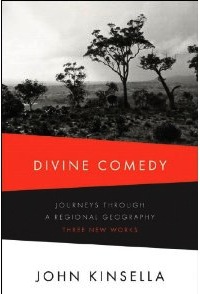
| Jacket 40 — Late 2010 | Jacket 40 Contents | Jacket Homepage | Search Jacket |
This piece is about 4 printed pages long.
It is copyright © Sara Wintz and Jacket magazine 2010. See our [»»] Copyright notice.
The Internet address of this page is http://jacketmagazine.com/40/r-kinsella-rb-wintz.shtml
John Kinsella
Divine Comedy: Journeys through a Regional Geography
reviewed by
Sara Wintz
409 pp. (University of Queensland Press). www.uqp.com.au. US $34.95 paper
978–0-7022–3666-2

1
I embarked upon reading John Kinsella’s epic Divine Comedy: Journeys through a Regional Geography hoping that it would bring me to a greater understanding of the place of Australia, in my mind. A complete understanding of which, as an English-speaking poet living in the United States, may remain hopelessly incomplete while reading in opposition to long distance.
2
In Divine Comedy: Journeys through a Regional Geography, Australian poet John Kinsella explores the five-acre plot surrounding his childhood home by incorporating regional dialect, naming of local vegetation, and personal detail, into the format of Dante’s The Divine Comedy. Like Dante’s epic tale that came before, Kinsella’s book is comprised of “Purgatorio,” “Paradiso,” and “Inferno” sections. Kinsella eschews direct translation from Italian, in favor of “distractions” upon themes from the classic text: Tracy Ryan, Kinsella’s partner, plays the part of Beatrice, “The Inferno” becomes “The Inferno: Leisure Centre.”
3
I found Kinsella’s book far more interesting as a psychogeographic journey, than I did a new work based on a classic text. (But maybe that’s because I’m less interested in The Divine Comedy than I am in The Situationists and Robert Smithson.) As such, I will focus this review on Kinsella’s replication of physical/emotional landscape within a text, and the possibility (or impossibility) of immersion.
4
What becomes interesting to me, in this book, is how possible or impossible it may be to enter and understand a replicated physical world that exists inside of a text. Perhaps this is because Kinsella does everything possible to enable that visceral sensation: his descriptive phrases feel thorough, his voice is clear. I even relate to voice of the narrator who “speaks” to me. Nevertheless, I found it difficult to become engrossed enough to feel re-located from my bedroom in Brooklyn. And having felt that euphoric, immersive sensation in the past, with Kinsella’s work — it is possible! But perhaps not in this book.
5
What’s up with my standards? When Kinsella says “for a poet to really come to grips with place, the best thing might be complete immersion — say, for example, writing about one small space consistently over the period of a year.” (Divine Comedy, 3) Robert Smithson once wrote, “To understand this language of sites is to appreciate the metaphor between the syntactical construct and the complex of ideas, letting the former function as a three dimensional picture which doesn’t look like a picture.” (Collected Writings, 364) After Kinsella’s writing about a space for a year, I just expected the end result to feel more like a site, to me.
6
Perhaps it has something to do with having read his other books where my yearning for a sense of location was more satisfied. Let’s take a brief look at his poem, “The Silo,” for example:
7
Visitors, as if they knew, never remarked
on the old silo with its rammed earth walls
and the high thatched roof, incongruous amongst
the new machinery and silver field bins.
Nor the workers brought in at harvest time,
trucks rolling past the ghostly whimperings,
snarls and sharp howls cutting the thick silo’s
baffling. Nor when a bumper harvest filled
every bin and the farmer was hungry
for space — no one ever mentioned bringing
the old silo back into service…
And lightning dragging a moon’s bleak halo
to dampen the eruption, with thunder
echoing out over the bare paddocks
towards the farmhouse where an old farmer
consoled his bitter wife on the fly-proof
verandah, cursing the cockatoos, hands
describing a prison from which neither
could hope for parole, petition, release.
8
I love this poem. This is probably one of my favorite poems by anyone, ever. One of the reasons why I love it, is that it contains a scene with characters, loose dialogue, cause and effect. I can step into it like an episode, or an act in a play, and think about where it has come from and what has happened. I feel for the silo, the farmer and the farmer’s wife. Even the cockatoo, a little.
9
But in John Kinsella’s Divine Comedy, his conversation with the form of Dante’s work distracted me. Unlike “The Silo,” I felt like I already knew too much. Consequences and situations evoked in Divine Comedy became somewhat predictable in Kinsella’s text — because of its relation to a body of work already considered to be an original. Within an already predictable form, even Kinsella’s comparison of leisure center to hellish inferno, in the section dubbed “Inferno: Leisure Centre” seemed a bit obvious, however much I related to its tone. Of course someone who writes:
10
CEOs squabble over
the quantity of angels
it takes to counteract the utility of insider
trading: ultrasound. They
pray in their own way: Dick and Dora, their phantasmagoria
Dr Frankenstein and The Team,
cleared by ethics committees.
Productivity. Making fat lean.
New trees, new fruit, new contracts.
(Divine Comedy, 175–176)
11
… would compare a leisure centre to an inferno. And that predictability, distracted me. It stymied my desire to step into his world. As a result, my response became a more remote one — to listen — as opposed to engagement with the text.
12
Kinsella follows the outline (Dante’s) to a T, and the end result is interesting as an idea but fails to recognize its own complications. Kinsella seems to expect that we are right there in Australia with him and I am, however disappointingly, not, because of how closely he follows the outline of an original “immersive” work. For someone who so successfully paints an original and lush landscape in the past, why does he not now? As Kinsella does, here when he says,
13
This
had been the way for as far back as could
be remembered. Thin sprays of baby’s breath
grew around its foundations, while wedding
bouquet sprouted bizarrely from the grey
mat of thatching. (“The Silo”)
14
Why is a secondary, immersive landscape, not possible? I found myself wanting to absorb endless, new information and unexpected description. And I suppose, regarding the content of Kinsella’s Divine Comedy, I anticipated too much, or already knew what might happen. I found myself wanting to step into Kinsella’s landscape but failed to find an entry point that made immersion desirable. His plot was so predictable that it became, itself, a distraction. Despite my desire to step into an Australian landscape, Kinsella’s “syntactical construct” left me anxiously in limbo.
Flam, Jack. ed Robert Smithson: The Collected Writings. Berkeley: University of California Press, 1996.
Kinsella, John. Silo: A Pastoral Symphony. Fremantle: Fremantle Arts Centre Press, 1995.

Sara Wintz
Sara Wintz is a writer and curator living in Brooklyn. Her writing has appeared in Ecopoetics, Cricket Online Review, Interrobang?!, The Poetry Project Newsletter, and on Ceptuetics. She is an MFA Candidate in Creative Writing, in the Milton Avery School of Graduate Studies at Bard College.